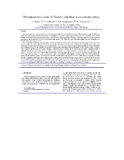Please use this identifier to cite or link to this item:
http://hdl.handle.net/10311/385| Title: | Mesoproterozoic rocks of Namibia and their plate tectonic setting |
| Authors: | Becker, T. Schreiber, U. Kampunzu, A.B. Armstrong, R. |
| Keywords: | Namaqua Belt Sinclair Group Subduction Docking; Lithosphere delamination Mesoproterozoic Namibia |
| Issue Date: | 2006 |
| Publisher: | Elsevier www.elsevier.com/locate/jafrearsci |
| Citation: | Becker, T. et al (2006) Mesoproterozoic rocks of Namibia and their plate tectonic setting, Journal of African Earth Sciences, Vol. 46, pp. 112–140 |
| Abstract: | Two main Mesoproterozoic provinces occur in southern Namibia: (1) The high-grade Namaqua Metamorphic Complex (NMC) composed of a supracrustal sedimentary succession and interpreted as a passive margin sequence in the west of the Kalahari craton; (2) The Sinclair Group and its northeastern correlatives, composed of two main magmatic and metamorphic units, reflecting northeast-directed subduction, which started before 1.37 Ga and lasted until about 1.1 Ga. These two units were tectonically juxtaposed during the 1.1– 1.03 Ga Namaqua orogenic event. The Kairab–Kumbis Metamorphic Complex comprises metasedimentary and metavolcanic rocks intruded by the 1.37 Ga arc-related Aunis tonalite. The mafic volcanic rocks from this complex have geochemical features of island arc calcalkaline basalts; they were emplaced and metamorphosed along an active margin before 1.37 Ga. The 1.2–1.1 Ga low-grade unmetamorphosed volcanic and immature sedimentary rocks of the Sinclair Group and its northwestern equivalents rest disconformably on the Kairab–Kumbis Complex. They occur in fault-bounded depocenters defining a regional arc-shape structure up to 100 km-wide and with a minimum length of 2000 km. The plate tectonic setting of this arc is best constrained by the composition of volcanic rocks from the 1.2 Ga Barby Formation and coeval granitoids; they comprise high-K calcalkaline rocks suggesting emplacement in an active continental margin setting. The final stage of this continental arc evolution is recorded in the <1.1 Ga tholeiites of the Opdam Formation. High Ti-content and flat REEpatterns in the tholeiites suggests an extensional event, whereas high Th/Ta and La/Nb ratios, low Ce/Pb values and negative anomalies for Nb–Ta suggest a subduction-related setting for the mantle source from which the mafic magmas were derived. Docking of continents led to the slab detachment, allowing interaction between the asthenospheric mantle and the mantle wedge enriched during the subduction process. The magmatic underplating related to this event induced the genesis of large-scale batholitic granitoid bodies in the NMC and a 1.1–1.0 Ga high-grade LP/HT metamorphism, with mineral assemblages indicating an anti-clockwise P–T–t path. |
| URI: | http://hdl.handle.net/10311/385 |
| ISSN: | 1464-343X |
| Appears in Collections: | Research articles (Dept of Geology) |
Files in This Item:
| File | Description | Size | Format | |
|---|---|---|---|---|
| Kampunzu2006RocksofNamibia.pdf | 3.36 MB | Adobe PDF |  View/Open |
Items in DSpace are protected by copyright, with all rights reserved, unless otherwise indicated.
